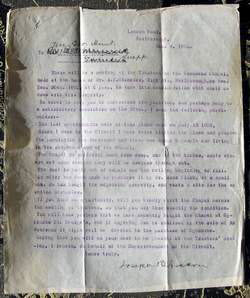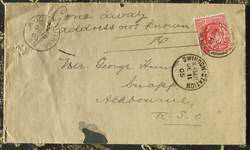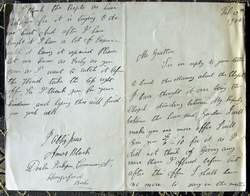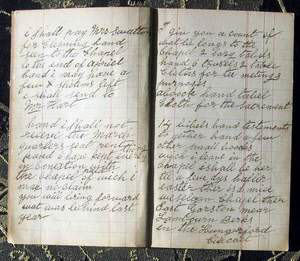Abandoned Communities ..... Snap
Two generations of the Bates family are recorded between 1861 and 1891. In 1861 Thomas and Ann Bates, aged 46 and 42, and their five children lived at the carter’s cottage on plot 79, Thomas having the occupation of carter. Thomas and Ann were not recorded in 1871, but their oldest son, John, then 32 and his wife, Hannah, aged 36, were living in one of the cottages on plot 80 with their four children. John was an agricultural labourer. They were still there in 1881, when there is no mention of their two oldest daughters, but their son, William, aged 14, is now recorded as an agricultural labourer. In addition there is now a younger son, Thomas, aged 7, a scholar.
In 1891 John and Hannah Bates were still living in Snap, but all their children had left. Hannah died in June 1894, and then in 1896 John moved to East Garston, a few miles north of Hungerford. We know this because, before his departure, John Bates had been a trustee of the Methodist chapel in Woodsend with responsibility for keeping the accounts. His account book is still in existence, in the possession of Ken Hillier. It is a delightful and fascinating document, and I have therefore reproduced some pages from it at the bottom of the page. On the last page but one John Bates states that he intends to move to East Garston a few days after Easter.
At the time of his departure John Bates would have been 56. In East Garston he moved in with his daughter Emily. John’s son Thomas had left Snap some time before 1891, and went to work in the Great Western Railway works in Swindon.
The changes in farming practice that caused people to move away from Snap resulted mainly from the decline in the price of grain during the second half of the nineteenth century. Until 1846 the Corn Laws gave British farmers protection against foreign imports of grain. After the repeal of the Corn Laws the price of grain fell, especially when imports of wheat from the USA increased rapidly during the 1870s. As the price of wheat and other grain crops fell farmers and landowners looked for other ways to generate income from their land. The demand for farm labour was also affected by the introduction of new machinery during this period. Many workers were laid off, and according to the census records for Britain as a whole there were over 90,000 fewer agricultural workers in 1881 than there had been a decade earlier.
I do not have precise information about the fate of Snap farm towards the end of the nineteenth century. There may have been periods when it had no tenant farmer. At some date before 1901 it was taken on by John Osmond from London, who was 26 in that year, and it is likely that some of the people living there at the time of the 1901 census were given jobs by him. But by 1905 Osmond too had departed. In that year Snap farm and the neighbouring Leigh farm were bought by Henry Wilson, a butcher and sheep dealer based in Ramsbury. Wilson turned the two farms into a sheep run, an enterprise that could be managed by a single shepherd.
Later in 1905 the Methodist chapel at Woodsend was closed and put up for sale. Woodsend too suffered some loss of population, but it survived and remains as a hamlet today. On 4 December 1905 the Methodist minister in Marlborough, Joseph Gratton, wrote to the trustees of the chapel inviting them to a meeting at which a decision about the chapel would be taken. One of his letters, addressed to George Hunt of Snap, is reproduced on the left, together with its envelope. The letter could not be delivered as George Hunt had “gone away”.
In the letter Joseph Gratton describes the state of the chapel, and mentions that an offer to buy it had come from Amos Black. Black, a horse dealer, had offered £4, seeing the building as a suitable home for himself and his wife Betsy. Negotiations between Gratton and Black continued through January and February 1906, and the outcome was that the chapel was eventually sold to Amos Black for £6 15s.
Ken Hillier has the correspondence between Joseph Gratton and Amos Black. One of Black’s letters, dated 12 February 1906, is reproduced on the left. In that letter Black expressed concern about the condition of the chapel roof, fearing that a strong wind might take it right off.
In 1891 John and Hannah Bates were still living in Snap, but all their children had left. Hannah died in June 1894, and then in 1896 John moved to East Garston, a few miles north of Hungerford. We know this because, before his departure, John Bates had been a trustee of the Methodist chapel in Woodsend with responsibility for keeping the accounts. His account book is still in existence, in the possession of Ken Hillier. It is a delightful and fascinating document, and I have therefore reproduced some pages from it at the bottom of the page. On the last page but one John Bates states that he intends to move to East Garston a few days after Easter.
At the time of his departure John Bates would have been 56. In East Garston he moved in with his daughter Emily. John’s son Thomas had left Snap some time before 1891, and went to work in the Great Western Railway works in Swindon.
The changes in farming practice that caused people to move away from Snap resulted mainly from the decline in the price of grain during the second half of the nineteenth century. Until 1846 the Corn Laws gave British farmers protection against foreign imports of grain. After the repeal of the Corn Laws the price of grain fell, especially when imports of wheat from the USA increased rapidly during the 1870s. As the price of wheat and other grain crops fell farmers and landowners looked for other ways to generate income from their land. The demand for farm labour was also affected by the introduction of new machinery during this period. Many workers were laid off, and according to the census records for Britain as a whole there were over 90,000 fewer agricultural workers in 1881 than there had been a decade earlier.
I do not have precise information about the fate of Snap farm towards the end of the nineteenth century. There may have been periods when it had no tenant farmer. At some date before 1901 it was taken on by John Osmond from London, who was 26 in that year, and it is likely that some of the people living there at the time of the 1901 census were given jobs by him. But by 1905 Osmond too had departed. In that year Snap farm and the neighbouring Leigh farm were bought by Henry Wilson, a butcher and sheep dealer based in Ramsbury. Wilson turned the two farms into a sheep run, an enterprise that could be managed by a single shepherd.
Later in 1905 the Methodist chapel at Woodsend was closed and put up for sale. Woodsend too suffered some loss of population, but it survived and remains as a hamlet today. On 4 December 1905 the Methodist minister in Marlborough, Joseph Gratton, wrote to the trustees of the chapel inviting them to a meeting at which a decision about the chapel would be taken. One of his letters, addressed to George Hunt of Snap, is reproduced on the left, together with its envelope. The letter could not be delivered as George Hunt had “gone away”.
In the letter Joseph Gratton describes the state of the chapel, and mentions that an offer to buy it had come from Amos Black. Black, a horse dealer, had offered £4, seeing the building as a suitable home for himself and his wife Betsy. Negotiations between Gratton and Black continued through January and February 1906, and the outcome was that the chapel was eventually sold to Amos Black for £6 15s.
Ken Hillier has the correspondence between Joseph Gratton and Amos Black. One of Black’s letters, dated 12 February 1906, is reproduced on the left. In that letter Black expressed concern about the condition of the chapel roof, fearing that a strong wind might take it right off.
Three
Letter from Joseph Gratton to George Hunt, 4 December 1905
Envelope in which Joseph Gratton’s letter was sent
Letter from Amos Black to Joseph Gratton, 12 February 1906
Pages from the account book of Woodsend chapel





